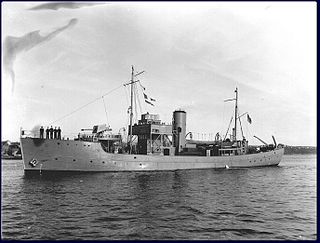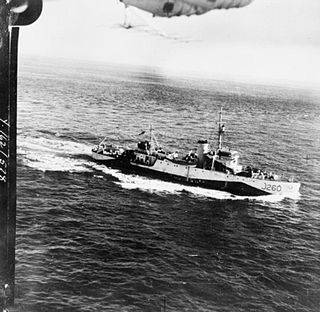Service history
The vessel was constructed at the Marine Industries shipyard at Sorel, Quebec in 1941–1942 and given the yard number 105. The ship was launched in December 1942 and named Provider.Provider was commissioned on 1 December, the second vessel of its design to enter Canadian service after sister ship Preserver. Provider sailed for Halifax, Nova Scotia and was transferred to the Caribbean Sea with two flotillas of Fairmile Motor Launches. However, while en route, Provider was damaged in a storm and was forced to return to Halifax. Provider departed Halifax on 29 December and arrived at Trinidad on 20 February 1943. There, Provider and the flotillas alleviated the shortage of patrol forces in the region, with Provider acting as the base ship for the Fairmiles. Provider sailed for Guantánamo Bay, Cuba and was joined there by the 73rd Flotilla of Fairmile Motor Launches. The two units then moved on to Key West, Florida. Provider returned to Halifax on 23 April 1943.
Provider was then allocated to Gaspé Force, arriving at Gaspé, Quebec on 23 April in the Gulf of St. Lawrence. The vessel was then sent further up the St. Lawrence River to Sept-Îles, Quebec arriving on 29 June and remaining there until November. Provider then sailed for Halifax, before heading on to Bermuda to serve as base ship for the 70th and 78th Fairmile flotillas. The vessel returned to Halifax on 31 July 1944, before being attached to HMCS Somers Isles, the Canadian training base at Bermuda until the end of May 1945. The ship returned to Halifax to become the base supply ship before being paid off on 22 March 1946.
The ship was sold in 1946 to Lunham & Moore (Tankers) Ltd and converted into a tanker. Registered in Montreal, the vessel was renamed Maruba and re-entered service in 1947. Maruba was sold to Empresa Petrolera Fiscal in 1956, renamed Olaya and registered in Callao. The same year, the vessel was renamed Orgenos. In 1960, the Peruvian Navy acquired Orgenos but the vessel was taken out of service in 1961 and sold for scrap. Orgenos was broken up in Peru in 1961, but the vessel's registry was not deleted until 1992. [lower-alpha 2]
The Cape class consists of two escort maintenance ships of the Royal Canadian Navy (RCN). The ships were built in Canada as Beachy Head-class maintenance ships for the Royal Navy, but were acquired by Canada in 1952. They were commissioned into the RCN in 1959 as HMCS Cape Breton and HMCS Cape Scott. Cape Scott served on the east coast until 1972, after which the ship became a stationary repair vessel at Halifax, Nova Scotia until 1975. The vessel was broken up in 1978. Cape Breton served initially as a school ship on the east coast before transferring to the west coast of Canada in 1959. The maintenance ship remained in service until 1964, when she was laid up at Esquimalt, British Columbia as a maintenance facility. Cape Breton remained in this service until 1993. The vessel was then sold for use as an artificial reef and sunk off the coast of British Columbia.

HMCS Gaspé was a Fundy-class minesweeper that served in the Royal Canadian Navy from 1938 to 1945. She saw service during the Second World War as part of the local defence of Halifax, Nova Scotia. She was named for Gaspé Bay in Quebec. Following the war the ship was sold for mercantile use, becoming the tugboat Sung Li. The ship's registry was deleted in 1993.
HMCS Venture was a three-masted schooner built for the Royal Canadian Navy as a training ship in 1937. She served during the Second World War at Halifax, Nova Scotia. She was the second vessel commissioned by the Royal Canadian Navy to bear the name Venture. In 1943, the schooner was renamed Harbour Craft 190. The schooner was sold to private interests following the war and renamed Alfred & Emily before being lost by fire in 1951.
HMCS Reindeer was an armed yacht that served in the Royal Canadian Navy during the Second World War. She served mainly in local waters, escorting convoys until becoming a training ship at Halifax, Nova Scotia at the end of 1942. The ship remained as such until being paid off to reserve in 1945 and was sold. Constructed as Josephine in 1926 in the United States and renamed Mascotte, the yacht was acquired by the Royal Canadian Navy in 1940. Following the war, the vessel was sold.
HMCS Transcona was a Bangor-class minesweeper built for the Royal Canadian Navy during the Second World War. She was launched on 26 April 1941. After the war, she was transferred to the Royal Canadian Mounted Police under the name French. The vessel served until 1961 before being sold for scrap and broken up later that year.

HMCS Goderich was a Bangor-class minesweeper constructed for the Royal Canadian Navy during the Second World War. Entering service in 1941, Goderich spent the entire war as a local convoy escort based out of Halifax, Nova Scotia. The vessel was decommissioned in 1945 and placed in reserve. Reacquired during the Korean War, the vessel was modernized but never re-entered service and was sold for scrap and broken up in 1959.
HMCS Mahone was a Bangor-class minesweeper constructed for the Royal Canadian Navy during the Second World War. Entering service in 1941, the ship took part in the Battle of the Atlantic and the Battle of the Saint Lawrence as a convoy escort. Following the war, the minesweeper was decommissioned and placed in reserve. Reacquired during the Korean War, Mahone was never recommissioned into the Royal Canadian Navy and was instead sold to the Turkish Navy in 1958. Renamed Beylerbeyi, the minesweeper remained in service until 1972 when she was discarded.
HMCS Malpeque was a Bangor-class minesweeper constructed for the Royal Canadian Navy during the Second World War. Entering service in 1941, the minesweeper took part in the Battle of the Atlantic and the invasion of Normandy. Malpeque was decommissioned in 1945 and placed in reserve. The vessel was reacquired during the Korean War, however the ship never re-entered service and was sold for scrap in 1959.
HMCS Medicine Hat was a Bangor-class minesweeper that served with the Royal Canadian Navy during the Second World War. Entering service in 1941, the minesweeper was primarily used as a convoy escort in the Battle of the Atlantic and the Battle of the St. Lawrence. Following the war the vessel was laid up until reacquired during the Korean War. Never re-entering service with the Royal Canadian Navy, Medicine Hat was sold to the Turkish Navy in 1957. Renamed Biga, the minesweeper was discarded in 1963.
HMCS Swift Current was a Bangor-class minesweeper that served with the Royal Canadian Navy during the Second World War. Entering service in 1941, the warship used as a training ship and convoy escort and took part in the battles of the St. Lawrence and the Atlantic. Following the war the ship was laid up until reacquired during the Korean War. Never re-entering service with Canada, Swift Current was sold to the Turkish Navy in 1958. Renamed Bozcaada, the minesweeper was discarded in 1971.

HMCS Blairmore was a Bangor-class minesweeper that served with the Royal Canadian Navy during the Second World War. Entering service in 1942, the ship took part in the Battle of the Atlantic and the invasion of Normandy. Following the war, the ship was laid up until 1958 when the Blairmore was transferred to the Turkish Navy. Renamed Beycoz, the vessel was discarded in 1971.
HMCS Fort William was a Bangor-class minesweeper that served with the Royal Canadian Navy during the Second World War. Entering service in 1942, the minesweeper participated in the Battle of the Atlantic as a convoy escort and in the invasion of Normandy. Following the war, the ship was laid up, but was reacquired during the Korean War. Fort William never re-entered service with the Royal Canadian Navy and in 1957, was sold to Turkey. Renamed Bodrum by the Turkish Navy, the ship was discarded in 1971.

HMCS Kenora was a Bangor-class minesweeper that served with the Royal Canadian Navy during the Second World War. Entering service in 1942, the minesweeper took part in the Battle of the Atlantic as a convoy escort and in the invasion of Normandy. Following the war, the vessel was laid up until reacquired in 1952 during the Korean War. Never re-entering service with the Royal Canadian Navy, Kenora was sold to the Turkish Navy in 1957. Renamed Bandirma by the Turkish Navy, the vessel was discarded in 1972.
HMCS Milltown was a Bangor-class minesweeper that served with the Royal Canadian Navy during the Second World War. The vessel entered service in 1942 and took part in the Battle of the Atlantic, Battle of the St. Lawrence and the invasion of Normandy. Milltown was laid up following the war, but reacquired in 1952 during the Korean War. The ship never re-entered service with the Royal Canadian Navy and was sold for scrap in 1959.
HMCS Port Hope was a Bangor-class minesweeper that served with the Royal Canadian Navy during the Second World War. The minesweeper entered service in 1942 and for the majority of the war, served as a patrol and escort ship along the coasts of Atlantic Canada and Newfoundland, participating in the Battle of the St. Lawrence. Following the war the vessel was laid up until reacquired by the Royal Canadian Navy during the Korean War. Port Hope never re-entered service and was sold for scrap and broken up in 1959.

HMCS Westmount was a Bangor-class minesweeper that served with the Royal Canadian Navy during the Second World War. Entering service in 1942, the minesweeper spent the entire war on the Atlantic Canada coast. Following the war, the ship was laid up in reserve until reacquired in 1952 during the Korean War. Never re-entering service with the Royal Canadian Navy, the vessel was sold to the Turkish Navy in 1958. Renamed Bornova, the minesweeper was discarded in 1972.
HMCS Truro was a Bangor-class minesweeper that served with the Royal Canadian Navy during the Second World War. The minesweeper entered service in 1942 and took part in the Battle of the Atlantic and the Battle of the St. Lawrence. Following the war, the vessel was transferred to the Royal Canadian Mounted Police and renamed Herchmer. In 1946, Herchmer was sold for mercantile conversion and reappeared as Gulf Mariner. The ship was abandoned in 1964 on the Fraser River shore after plans for conversion to a suction dredger failed. The abandoned hulk was broken up.
HMCS Gaspé was a Bay-class minesweeper that was constructed for the Royal Canadian Navy during the Cold War. The vessel entered service in 1953 and remained with the Royal Canadian Navy until 1958. That year, the ship was transferred to the Turkish Navy and renamed Trabzon. The vessel remained in service until 1991.
HMCS Ungava was a Bay-class minesweeper that was constructed for the Royal Canadian Navy during the Cold War. Entering service in 1954, the minesweeper was paid off in 1958 and transferred to the Turkish Navy. Renamed Tekirdağ, the ship remained in service until 1991 and was broken up in 2002.

HMCS Preserver was a depot ship of the Coastal Forces of the Royal Canadian Navy during World War II. Commissioned in July 1942, Preserver supported Canadian Fairmile B motor launches in Canadian and Newfoundland waters during the war.






